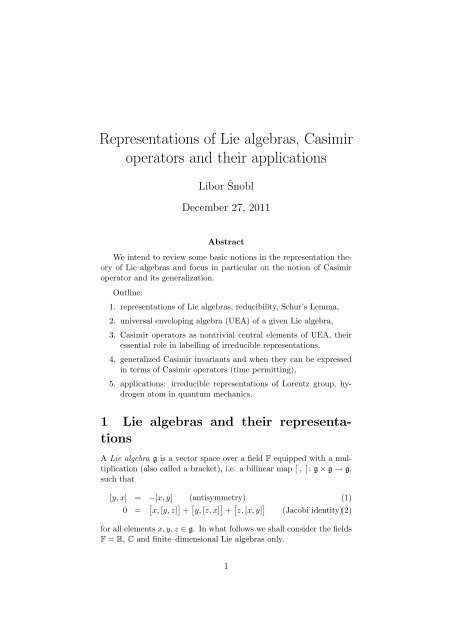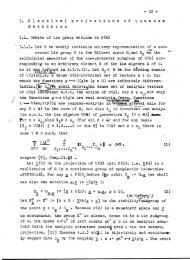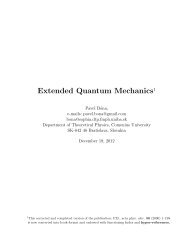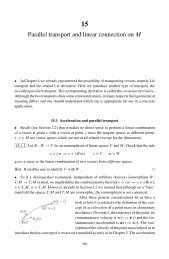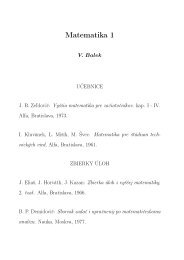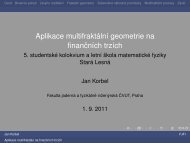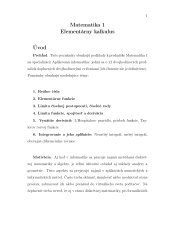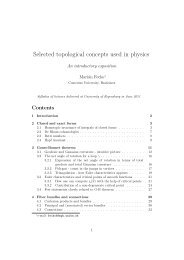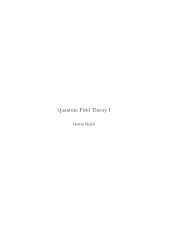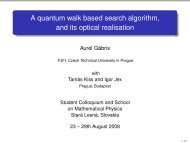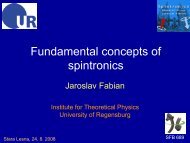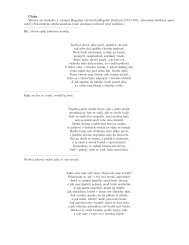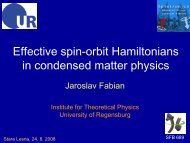Representations of Lie algebras, Casimir operators and their ...
Representations of Lie algebras, Casimir operators and their ...
Representations of Lie algebras, Casimir operators and their ...
Create successful ePaper yourself
Turn your PDF publications into a flip-book with our unique Google optimized e-Paper software.
<strong>Representations</strong> <strong>of</strong> <strong>Lie</strong> <strong>algebras</strong>, <strong>Casimir</strong><strong>operators</strong> <strong>and</strong> <strong>their</strong> applicationsLibor ŠnoblDecember 27, 2011AbstractWe intend to review some basic notions in the representation theory<strong>of</strong> <strong>Lie</strong> <strong>algebras</strong> <strong>and</strong> focus in particular on the notion <strong>of</strong> <strong>Casimir</strong>operator <strong>and</strong> its generalization.Outline:1. representations <strong>of</strong> <strong>Lie</strong> <strong>algebras</strong>, reducibility, Schur’s Lemma,2. universal enveloping algebra (UEA) <strong>of</strong> a given <strong>Lie</strong> algebra,3. <strong>Casimir</strong> <strong>operators</strong> as nontrivial central elements <strong>of</strong> UEA, <strong>their</strong>essential role in labelling <strong>of</strong> irreducible representations,4. generalized <strong>Casimir</strong> invariants <strong>and</strong> when they can be expressedin terms <strong>of</strong> <strong>Casimir</strong> <strong>operators</strong> (time permitting),5. applications: irreducible representations <strong>of</strong> Lorentz group, hydrogenatom in quantum mechanics.1 <strong>Lie</strong> <strong>algebras</strong> <strong>and</strong> <strong>their</strong> representationsA <strong>Lie</strong> algebra g is a vector space over a field F equipped with a multiplication(also called a bracket), i.e. a bilinear map [ , ]: g × g → g,such that[y, x] = −[x, y] (antisymmetry) (1)0 = [ x, [y, z] ] + [ y, [z, x] ] + [ z, [x, y] ] (Jacobi identity)(2)for all elements x, y, z ∈ g. In what follows we shall consider the fieldsF = R, C <strong>and</strong> finite–dimensional <strong>Lie</strong> <strong>algebras</strong> only.1
The structure <strong>of</strong> the <strong>Lie</strong> algebra g can be represented in any chosenbasis (e j ) dim gj=1by the corresponding structure constants c jklin thebasis (e j ) dim gj=1[e j , e k ] =dim∑gl=1c jk l e l . (3)A fundamental theorem due to E. E. Levi [1, 2, 3] provides a generalscheme for the structure <strong>of</strong> <strong>Lie</strong> <strong>algebras</strong>.Theorem 1 (Theorem <strong>of</strong> Levi) Let g be a finite-dimensional <strong>Lie</strong>algebra over a field F <strong>and</strong> r = R(g) be its radical. Then there exists asemisimple subalgebra p <strong>of</strong> g such thatg = p ∔ r. (4)The subalgebra p is isomorphic to the factor algebra g/r <strong>and</strong> is uniqueup to automorphisms <strong>of</strong> g.Because r is a solvable ideal <strong>and</strong> p a semisimple subalgebra we have[p, p] = p, [p, r] ⊆ r, [r, r] r.A representation ρ <strong>of</strong> a given <strong>Lie</strong> algebra g on a vector space V isa linear map <strong>of</strong> g into the space gl(V ) <strong>of</strong> linear <strong>operators</strong> acting on Vρ: g → gl(V ): x → ρ(x)such that for any pair x, y <strong>of</strong> elements <strong>of</strong> gρ([x, y]) = ρ(x) ◦ ρ(y) − ρ(y) ◦ ρ(x) (5)holds. The field over which the vector space is defined must containF in order to have the representation well–defined, i.e. we may haverepresentations <strong>of</strong> real <strong>algebras</strong> on complex vector spaces but not viceversa. Dimension <strong>of</strong> the representation ρ is understood to be the sameas the dimension <strong>of</strong> the vector space V .A subspace W <strong>of</strong> V is called invariant ifρ(g)W = {ρ(x)w| x ∈ g, w ∈ W } ⊆ W.A representation ρ <strong>of</strong> g on V is reducible if a proper nonvanishinginvariant subspace W <strong>of</strong> V exists.A representation ρ <strong>of</strong> g on V is irreducible if no nontrivial invariantsubspace <strong>of</strong> V exists.2
A representation ρ <strong>of</strong> g on V is fully reducible when every invariantsubspace W <strong>of</strong> V has an invariant complement ˜W , i.e.V = W ⊕ ˜W , ρ(g) ˜W ⊆ ˜W . (6)In particular, any irreducible representation is also fully reducible.An important criterion for irreducibility <strong>of</strong> a given representationsisTheorem 2 (Schur’s Lemma) Let g be a complex <strong>Lie</strong> algebra <strong>and</strong>ρ its representation on a finite–dimensional vector space V .1. Let ρ be irreducible. Then any operator A on V which commuteswith all ρ(x),[A, ρ(x)] = 0, ∀x ∈ g,has the form A = λ1 for some complex number λ.2. Let ρ be fully reducible <strong>and</strong> such that every operator A on Vwhich commutes with all ρ(x) has the form A = λ1 for somecomplex number λ. Then ρ is irreducible.The adjoint representation <strong>of</strong> a given <strong>Lie</strong> algebra g is a linear map<strong>of</strong> g into the space gl(g) <strong>of</strong> linear <strong>operators</strong> acting on gad: g → gl(g): x → ad(x)defined for any pair x, y <strong>of</strong> elements <strong>of</strong> g viaad(x) y = [x, y]. (7)When convenient we may also use an alternative notation ad x = ad(x).The image <strong>of</strong> ad is denoted by ad(g).2 Universal enveloping <strong>algebras</strong> <strong>and</strong><strong>Casimir</strong> <strong>operators</strong>Universal enveloping algebra is an important object in the representationtheory <strong>of</strong> <strong>Lie</strong> <strong>algebras</strong>. It is defined as a certain factoralgebra<strong>of</strong> the tensor algebra <strong>of</strong> a given <strong>Lie</strong> algebra g.The tensor algebra (or free algebra) <strong>of</strong> the vector space V over thefield F is the vector spaceT (V ) = ⊕ ∞ k=0 V ⊗k = F ⊕ V ⊕ V ⊗ V ⊕ . . . ⊕ V ⊗k ⊕ . . .equipped with the associative multiplication generated by the multiplication<strong>of</strong> decomposable elements(v 1 ⊗ v 2 ⊗ . . . ⊗ v k ) · (w 1 ⊗ . . . ⊗ w l ) = v 1 ⊗ v 2 ⊗ . . . ⊗ v k ⊗ w 1 ⊗ . . . ⊗ w l .3
When the vector space V is in addition a <strong>Lie</strong> algebra V = g,one may consider a two–sided ideal J in the associative algebra T (g)generated by the elements <strong>of</strong> the form x ⊗ y − y ⊗ x − [x, y], i.e.J = span {A ⊗ (x ⊗ y − y ⊗ x − [x, y]) ⊗ B | x, y ∈ g, A, B ∈ T (g)} .The factoralgebraU(g) = T (g)/J (8)is called the universal enveloping algebra <strong>of</strong> the <strong>Lie</strong> algebra g. It isobvious that universal enveloping <strong>algebras</strong> are associative <strong>algebras</strong>,i.e. the notion <strong>of</strong> a universal enveloping algebra allows us to constructan infinite dimensional associative algebra out <strong>of</strong> any <strong>Lie</strong> algebra in acanonical way.The main reason why universal enveloping <strong>algebras</strong> are useful isthe following observation: any representation ρ <strong>of</strong> a <strong>Lie</strong> algebra g ona (finite–dimensional, for simplicity) vector space V gives rise to arepresentation ˜ρ <strong>of</strong> the tensor algebra T (g) defined by˜ρ(x 1 ⊗ x 2 ⊗ . . . ⊗ x k ) = ρ(x 1 ) · ρ(x 2 ) . . . ρ(x k ).The definition <strong>of</strong> a representation ρ, equation (5), implies that ˜ρ(J ) =0. Consequently, ˜ρ defines also a representation ˆρ <strong>of</strong> the universalenveloping algebra U(g) on the vector space Vˆρ(a) = ˜ρ(A), a = A mod J ∈ U(g), A ∈ T (g).<strong>Casimir</strong> <strong>operators</strong> are elements <strong>of</strong> the center <strong>of</strong> the universal envelopingalgebra U(g) <strong>of</strong> the <strong>Lie</strong> algebra g [4, 5, 6], i.e. such c ∈ U(g)thatc · a = a · cholds for all a ∈ U(g). A necessary <strong>and</strong> sufficient condition for c to bea <strong>Casimir</strong> operator isc · x = x · c, ∀x ∈ g ≃ g ⊗1 /J .We shall consider nontrivial <strong>Casimir</strong> <strong>operators</strong> only, i.e. thosedifferent from elements <strong>of</strong> F/J ≃ F. In order to avoid writing mod Jat all times we adopt a convention that <strong>Casimir</strong> <strong>operators</strong> shall bewritten as totally symmetric expressions in the elements <strong>of</strong> g. Thiscan be always accomplished using the identityx ⊗ y mod J = 1 2 (x ⊗ y + y ⊗ x) + 1 [x, y] mod J2as many times as needed, starting from the highest order terms <strong>and</strong>proceeding order by order. Such a procedure also implies the uniqueness<strong>of</strong> such totally symmetric representative <strong>of</strong> the equivalence class4
mod J . We shall occasionally suppress the tensor product sign, i.e.xy ≡ x ⊗ y.The importance <strong>of</strong> <strong>Casimir</strong> <strong>operators</strong> for the representation theory<strong>of</strong> complex <strong>Lie</strong> <strong>algebras</strong> comes from the Schur’s lemma, Theorem 2.In any representation ρ we have[ˆρ(c), ρ(x)] = 0, ∀x ∈ g.Consequently, if the representation ρ is irreducible, ˆρ(c) must be amultiple <strong>of</strong> the identity operator, λ1. The number λ depends on thechoice <strong>of</strong> the representation ρ <strong>and</strong> the <strong>Casimir</strong> operator c. If twoirreducible representations ρ 1 on V 1 <strong>and</strong> ρ 2 on V 2 are equivalent, i.e.if a linear transformation T : V 1 → V 2 exists such thatρ 2 (x) = T ◦ ρ 1 (x) ◦ T −1 , ∀x ∈ g,then necessarily we have λ 1 = λ 2 for the given <strong>Casimir</strong> invariant c.That means that the eigenvalues <strong>of</strong> ˆρ(c) can be used to distinguishinequivalent irreducible representations.If ρ is fully reducible but not irreducible then we may use theknowledge <strong>of</strong> <strong>Casimir</strong> <strong>operators</strong> <strong>of</strong> g in the decomposition <strong>of</strong> ρ into irreduciblecomponents. In particular, we construct common eigenspaces<strong>of</strong> all known <strong>Casimir</strong> <strong>operators</strong> <strong>and</strong> we know that each <strong>of</strong> them is aninvariant subspace (not necessarily irreducible for general g).The existence <strong>of</strong> nontrivial <strong>Casimir</strong> <strong>operators</strong> was established forcertain classes <strong>of</strong> <strong>Lie</strong> <strong>algebras</strong> only, e.g. for semisimple ones. Also<strong>Lie</strong> <strong>algebras</strong> with nonvanishing center, including all nilpotent ones,do possess nontrivial <strong>Casimir</strong> <strong>operators</strong>; namely, the elements <strong>of</strong> thecenter themselves. On the other h<strong>and</strong> some <strong>Lie</strong> <strong>algebras</strong> are known tohave no nontrivial <strong>Casimir</strong> invariants.Let us consider a semisimple complex <strong>Lie</strong> algebra g <strong>and</strong> its Killingform K. Let us take any basis (e 1 , . . . , e dim g ) <strong>of</strong> g <strong>and</strong> find the dualbasis (ẽ 1 , . . . , ẽ dim g ) such thatK(e k , ẽ j ) = δ j k .Let us assume that c ij k are the structure constants (3) <strong>of</strong> the <strong>Lie</strong>algebra g in the basis (e 1 , . . . , e k ). By the invariance <strong>of</strong> the Killingform K we havedim∑gK(e k , [e a , ẽ j ]) = −K([e a , e k ], ẽ j ) = −c j ak = −K(e k , c amjẽ m )which by nondegeneracy <strong>of</strong> K implies that[e a , ẽ j ] =dim∑gm=15c majẽ m .m=1
Let us construct an element <strong>of</strong> the universal enveloping algebra U(g)<strong>of</strong> the formC =dim∑gk=1ẽ k ⊗ e k =dim∑gk=1e k ⊗ ẽ k (9)(its symmetry comes from the fact that the Killing form is symmetric).Suppressing the tensor product signs <strong>and</strong> computing mod J , wehave for the commutator between e a ∈ g <strong>and</strong> C ∈ U(g)[e a , C] ===dim∑gk=1dim∑gk=1dim gk=1)(e a ẽ k e k − ẽ k e k e a =()(e a ẽ k − ẽ k e a ) e k + ẽ k (e a e k − e k e a ) =dim g∑∑([e a , ẽ k ] e k + ẽ k [e a , e k ]) = (c lakẽ l e k + c aklẽ k e l ) = 0.k,l=1We conclude that C is a <strong>Casimir</strong> operator <strong>of</strong> g. It is called the quadratic<strong>Casimir</strong> operator [4]. For its application in the pro<strong>of</strong> <strong>of</strong> Weyl’s theorem,see [5].We remark that the quadratic <strong>Casimir</strong> operator does not exhaustall independent <strong>Casimir</strong> <strong>operators</strong> <strong>of</strong> the semisimple <strong>Lie</strong> algebra gwhen we have rank g > 1. It is known that any semisimple <strong>Lie</strong> algebra<strong>of</strong> rank l has l independent <strong>Casimir</strong> <strong>operators</strong> which generate the wholecenter <strong>of</strong> the universal enveloping algebra U(g) through <strong>their</strong> products<strong>and</strong> linear combinations. Their explicit form depends on the details<strong>of</strong> the structure <strong>of</strong> the considered algebra g.<strong>Casimir</strong> invariants are <strong>of</strong> primordial importance in physics. They<strong>of</strong>ten represent such important quantities as angular momentum, elementaryparticle mass <strong>and</strong> spin, Hamiltonians <strong>of</strong> various physicalsystems etc.Example 1 Let us consider the angular momentum algebrawithso(3) = span{L 1 , L 2 , L 3 }[L j , L k ] =3∑ɛ jkl L l . (10)l=1The quadratic <strong>Casimir</strong> operator (9) isC = − 1 23∑L 2 l , (11)l=16
i.e. it coincides up to a numerical factor 1/2 with the square <strong>of</strong> angularmomentum, familiar from the construction <strong>of</strong> irreducible representations<strong>of</strong> the angular momentum algebra in quantum mechanics.Notice that the sign <strong>of</strong> the <strong>Casimir</strong> operator (11) is in fact the sameas used in physics: in quantum mechanics the <strong>operators</strong> <strong>of</strong> angularmomentum ˆL j (measured in multiples <strong>of</strong> ) satisfy the commutationrelations[ˆL j , ˆL3∑k ] = iɛ jkl ˆLlwhich differ from the ones in equation (10) by an extra imaginary unit.This extra i factor can be traced to the requirement that observablesare described by Hermitean <strong>operators</strong>; the generators <strong>of</strong> unitary representations<strong>of</strong> <strong>Lie</strong> groups are, on the contrary, anti–Hermitean. Anobvious remedy is to formally introduce a “physical” basis <strong>of</strong> a givenreal <strong>Lie</strong> algebraê j = ie j (12)l=1in which the original real structure constants[e j , e k ] = ∑ lf jk l e lbecome explicitly purely imaginary[ê j , ê k ] = ∑ lif jklê l .Example 2 Let us consider the Poincaré algebra iso(1, 3) (a.k.a. inhomogeneousLorentz algebra) spanned by M µν , P µ , µ, ν = 0, . . . , 3with the nonvanishing commutation relations[M µν , P ρ ] = η νρ P µ − η µρ P ν , (13)[M µν , M ρσ ] = η µσ M νρ + η νρ M µσ − η µρ M νσ − η νσ M µρ ,where η is the Minkowski metric η µν = η µν = diag(1, −1, −1, −1). Weshall use the metric η to move indices up <strong>and</strong> down, as is commonin the theory <strong>of</strong> relativity, <strong>and</strong> denote by ɛ µνρσ the covariant totallyantisymmetric tensor.The Poincaré algebra has a nontrivial Levi decomposition (4)iso(1, 3) = so(1, 3) ∔ rwith its semisimple factor being the Lorentz <strong>algebras</strong>o(1, 3) = span{M µν } µ,ν=0,1,2,37
<strong>and</strong> an Abelian radicalr = span{P µ } µ=0,1,2,3 .There are two independent <strong>Casimir</strong> <strong>operators</strong> <strong>of</strong> this <strong>Lie</strong> algebra,which are usually expressed asP 2 =3∑η µν P µ P ν <strong>and</strong> W 2 =µ=03∑η µν W µ W νµ=0where the quadruplet <strong>of</strong> quadratic elements <strong>of</strong> U(g)W µ = − 1 2 ɛ µνρσM νρ P σis called the Pauli–Lubanski vector. That means that in this case one<strong>of</strong> the <strong>Casimir</strong> <strong>operators</strong> is <strong>of</strong> second order in generators whereas theother is <strong>of</strong> fourth order.These two <strong>Casimir</strong> <strong>operators</strong> are essential in the construction <strong>of</strong>irreducible representations <strong>of</strong> the Poincaré algebra in relativistic quantumfield theory. Notice that in this case one constructs infinite–dimensional unitary representations.2.1 Energy spectrum <strong>of</strong> hydrogen atom in quantummechanicsIn order to further demonstrate the relevance <strong>of</strong> <strong>Casimir</strong> <strong>operators</strong>to physics, let us review another application, namely an algebraicdetermination <strong>of</strong> the hydrogen spectrum in quantum mechanics. Thiscomputation is originally due to Wolfgang Pauli [7].The Hamiltonian <strong>of</strong> an electron in hydrogen atom isĤ = 1 ∑ˆP j ˆPj − Q 2Mr , (14)jwhere ˆP j = −i ∂ ∂x jare <strong>operators</strong> <strong>of</strong> linear momenta in R 3 with the coordinatesx 1 , x 2 , x 3 , r = √ x 2 1 + x2 2 + x2 3 , M is the mass <strong>of</strong> the electron<strong>and</strong> Q =e24πɛ 0in SI units.The Hamiltonian (14) has three obvious integrals <strong>of</strong> motion, namelythe angular momentaˆL j = 1 ∑ɛ jkl ˆXk ˆPl ,k,l8
(chosen dimensionless for convenience) <strong>and</strong> three less obvious integrals<strong>of</strong> motion, namely the components <strong>of</strong> the Laplace–Runge–Lenz vectorˆK i = 12MQ∑ ∑kjɛ ikj ( ˆP k ˆLj + ˆL j ˆPk ) − 1 x i r . (15)The expression x irshould be interpreted as the operator <strong>of</strong> multiplicationby the given function <strong>of</strong> coordinates. For future reference, letus denote3∑3∑ˆL 2 = ˆL j ˆLj , ˆK2 = ˆK j ˆKj .j=1As it turns out, the knowledge <strong>of</strong> these integrals <strong>of</strong> motions <strong>and</strong><strong>their</strong> algebraic structure is enough to determine the spectrum <strong>of</strong> boundstates in the hydrogen atom.The crucial ingredients are the commutators between various componentsˆL j <strong>and</strong> ˆK j . By a somewhat lengthy but straightforward calculationwe find[ˆL j , ˆL k ] = i[ˆL j , ˆK k ] = ij=13∑ɛ jkl ˆLl , (16)l=13∑ɛ jkl ˆKl , (17)l=1[ ˆK j , ˆK k ] = − 2iMQ 23∑ɛ jkl ˆLl Ĥ. (18)l=1Another important observation is the operator identity3∑j=1ˆK j ˆLj = 0. (19)The commutator (18) prevents the <strong>operators</strong> ˆL j , ˆK j from forming a <strong>Lie</strong>algebra. Nevertheless, this bothersome property can be circumventedif we consider a given energy level, i.e. a subspace H E <strong>of</strong> the Hilbertspace H consisting <strong>of</strong> all eigenvectors <strong>of</strong> Ĥ with the given energy E.Operators ˆL j , ˆK j can be all restricted to H E because they commutewith Ĥ. When such restriction is understood, the Ĥ in equation (18)can be replaced by a numerical factor E <strong>and</strong> the algebra <strong>of</strong> ˆL j , ˆK jcloses. In particular, when E < 0 it is isomorphic to the <strong>Lie</strong> <strong>algebras</strong>o(4) = so(3) ⊕ so(3). When E > 0 the difference in sign leads to adifferent real form <strong>of</strong> the same complex <strong>Lie</strong> algebra, namely to so(1, 3).We shall be interested in bound states here, i.e. we assume E < 0.9
Once the energy is fixed we may introduce the <strong>operators</strong>(ˆL (1)j = 1 √ )ˆL j + − MQ222E ˆK j<strong>and</strong>ˆL (2)j = 1 2(ˆL j −√− MQ22E ˆK j)(notice that − MQ22Eis by assumption a positive number). The commutators<strong>of</strong> ˆL (1)j <strong>and</strong> ˆL (2)j now become[ˆL (1)j , ˆL (1)k ] = i[ˆL (2)j , ˆL (2)k ] = i[ˆL (1)j , ˆL (2)k ] = 0.3∑ɛ jkl ˆL(1)l ,l=13∑ɛ jkl ˆL(2)l ,That means that we have an explicit decomposition <strong>of</strong> our realization<strong>of</strong> so(4) into the direct sum so(3)⊕so(3) <strong>and</strong> that the two independent<strong>Casimir</strong> <strong>operators</strong> <strong>of</strong> so(4) can be expressed asor equivalently asC 1 = 1 4C 1 =l=13∑ˆL 2 (1)j , C 2 =j=13∑ˆL 2 (2)j ,j=1( √ ) 2 3∑ˆL j + − MQ22E ˆK j , C 2 = 1 4j=1( √ ) 2 3∑ˆL j − − MQ22E ˆK j .(20)The sum <strong>of</strong> these two <strong>Casimir</strong> <strong>operators</strong>, i.e. C 1 + C 2 , gives thequadratic <strong>Casimir</strong> operator (9) <strong>of</strong> so(4).From the theory <strong>of</strong> angular momentum, i.e. <strong>of</strong> representations <strong>of</strong>the <strong>Lie</strong> algebra so(3), we know that in any irreducible representation<strong>of</strong> so(4) we havej=1C 1 = p(p + 1)1, C 2 = q(q + 1)1for some nonnegative integer or half–integer values <strong>of</strong> p <strong>and</strong> q. Theirreducible representation <strong>of</strong> so(4) = so(3)⊕so(3) determined by thesevalues <strong>of</strong> the <strong>Casimir</strong> <strong>operators</strong> has dimension equal to (2p+1)×(2q +1).10
When we exp<strong>and</strong> the expressions for the <strong>Casimir</strong> <strong>operators</strong> (20)<strong>and</strong> subtract them, we find thatC 1 − C 2 =√− MQ22E3∑ˆL j ˆKjwhich vanishes in our representation, as we already know (cf. (19)).Therefore, only irreducible representations <strong>of</strong> so(4) with p = q arisein our problem.Let us now consider such a representation <strong>of</strong> so(4) with the givenvalues <strong>of</strong> E <strong>and</strong> p. The angular momentum ˆL j can be expressed asj=1ˆL j = ˆL (1)j + ˆL (2)j ,i.e. we can employ the st<strong>and</strong>ard result concerning the composition<strong>of</strong> two independent angular momenta <strong>and</strong> conclude that ˆL 2 takes allinteger values between |p − p| = 0 <strong>and</strong> p + p = 2p. In particular, thes–state, i.e. the state with ˆL 2 = 0, exists in our representation <strong>and</strong> is<strong>of</strong> interest to us. Let ψ be any s–state, i.e. a vector ψ ∈ H such thatˆL j ψ = 0. Obviously, ψ is a function <strong>of</strong> the radial coordinate r only.We have<strong>and</strong>ˆL 2 ψ = 0ˆK 2 ψ = 2MQ 2 Ĥψ + 1 2 ψby inspection <strong>of</strong> both sides <strong>of</strong> the equation when exp<strong>and</strong>ed in terms<strong>of</strong> ˆXj , ˆP j etc.When ψ in addition belongs to our representation <strong>of</strong> so(4) determinedby the values <strong>of</strong> E <strong>and</strong> p, we have the following value for thequadratic <strong>Casimir</strong> operator (9) <strong>of</strong> so(4)(C 1 + C 2 )ψ = 2p(p + 1)ψ = 1 ∑)(ˆL 22jψ − MQ22EˆK j 2 ψj(= − MQ2 2E4E MQ 2 + 1 ) 2 ψ. (21)Thus we have arrived at the condition8p(p + 1) = −2 − MQ2 2 Ewhich is just a different formulation <strong>of</strong> the celebrated Rydberg formulaE = − MQ22 2 1(2p + 1) 2 (22)11
where the potentially half–integer valued parameter p is traditionallyreplaced by the integer n = 2p+1 > 0. Once we have established thatE is determined by the value <strong>of</strong> p by equation (22) we also see thatH E coincides with the representation space <strong>of</strong> the so(4) irreduciblerepresentation labelled by p <strong>and</strong> q = p. On H E we may also writeequation (21) in the form( MQ2C 1 + C 2 = −4 2Ĥ + 1 )(23)2since both C 1 + C 2 <strong>and</strong> Ĥ take a constant value on H E. While itmay be tempting to consider this to be an operator identity validon the whole Hilbert space H, we don’t consider such interpretationlegitimate. In particular, on scattering states (E > 0) we even havea different <strong>Lie</strong> algebra. Therefore, equation (23) should be consideredat most on the bound state sector <strong>of</strong> our Hilbert space H.To sum up, we have seen that the spectrum <strong>of</strong> hydrogen atom canbe derived using the theory <strong>of</strong> <strong>Lie</strong> <strong>algebras</strong>, without explicit construction<strong>of</strong> eigenfunctions. More precisely, we have derived a necessarycondition (22) that any energy eigenvalue must satisfy. That this formulais physically relevant for all values <strong>of</strong> p ≥ 0 such that 2p ∈ Zis not a consequence <strong>of</strong> the computation just shown <strong>and</strong> shall be establishedby other means (e.g. by an explicit construction <strong>of</strong> s–statesintroduced above). Once the existence <strong>of</strong> at least one state with theenergy E n = − MQ2 1is shown, the degeneracy n 2 <strong>of</strong> the energy level2 2 n 2E n also follows directly from algebraic considerations.3 Generalized <strong>Casimir</strong> invariantsAs was shown by Kirillov in [8] <strong>and</strong> will be explained below, <strong>Casimir</strong><strong>operators</strong> are in one–to–one correspondence with polynomial invariantscharacterizing orbits <strong>of</strong> the coadjoint representation <strong>of</strong> g. Thesearch for invariants <strong>of</strong> the coadjoint representation is algorithmic<strong>and</strong> amounts to solving a system <strong>of</strong> linear first order partial differentialequations [9, 10, 11, 12, 13, 14, 15, 16, 17]. Alternatively, globalproperties <strong>of</strong> the coadjoint representation can be used [13, 18, 19, 20].In general, solutions are not necessarily polynomials <strong>and</strong> we shall callthe nonpolynomial solutions generalized <strong>Casimir</strong> invariants.For certain classes <strong>of</strong> <strong>Lie</strong> <strong>algebras</strong>, including semisimple <strong>Lie</strong> <strong>algebras</strong>,perfect <strong>Lie</strong> <strong>algebras</strong>, nilpotent <strong>Lie</strong> <strong>algebras</strong>, <strong>and</strong> more generallyalgebraic <strong>Lie</strong> <strong>algebras</strong>, all invariants <strong>of</strong> the coadjoint representationare functions <strong>of</strong> polynomial ones [9, 10].On the other h<strong>and</strong>, in the representation theory <strong>of</strong> solvable <strong>Lie</strong><strong>algebras</strong> <strong>their</strong> invariants are not necessarily polynomials, i.e. they can12
e genuinely generalized <strong>Casimir</strong> invariants. In addition to <strong>their</strong> importancein representation theory, they may occur in physics. Indeed,Hamiltonians <strong>and</strong> integrals <strong>of</strong> motion <strong>of</strong> classical integrable Hamiltoniansystems are not necessarily polynomials in the momenta [21, 22],though typically they are invariants <strong>of</strong> some group action.In order to calculate the (generalized) <strong>Casimir</strong> invariants we considersome basis (e 1 , . . . , e n ) <strong>of</strong> g, in which the structure constants arec ij k . The coadjoint representation ad ∗ <strong>of</strong> g is the representation on g ∗obtained via transposition <strong>of</strong> the <strong>operators</strong> in the adjoint representation〈ad ∗ (x)φ, y〉 = −〈φ, ad(x)y〉, ∀x, y ∈ g, φ ∈ g ∗ .A basis for the coadjoint representation is given by the first orderdifferential <strong>operators</strong> acting on functions on g ∗ , i.e. vector fields,Ê k =n∑a,b=1be b c ∂ka , 1 ≤ k ≤ n. (24)∂e aIn equation (24) the quantities e a are commuting independent variables– the coordinates in the basis <strong>of</strong> the space g ∗ , dual to the algebrag. Using the relation (g ∗ ) ∗ ≃ g one can identify them with the basisvectors <strong>of</strong> g.The invariants <strong>of</strong> the coadjoint representation, i.e. the generalized<strong>Casimir</strong> invariants, are solutions <strong>of</strong> the following system <strong>of</strong> partialdifferential equationsÊ k I(e 1 , . . . , e n ) = 0, k = 1, . . . , n. (25)The relation to <strong>Casimir</strong> <strong>operators</strong>, i.e. the 1–1 correspondencebetween polynomial solutions <strong>of</strong> equation (25) <strong>and</strong> the elements <strong>of</strong> thecenter <strong>of</strong> the enveloping algebra comes from the following observations.Firstly, it is obvious that both the operation on U(g) <strong>of</strong> taking thecommutator with a fixed element e k ∈ g <strong>and</strong> the application <strong>of</strong> thefirst order differential operator Êk satisfy Leibniz rule[e k , a 1 a 2 ] = [e k , a 1 ]a 2 + a 1 [e k , a 2 ], a 1 , a 2 ∈ U(g),Ê k (F 1 F 2 ) = Êk(F 1 )F 2 + F 1 Ê k (F 2 ), F 1 , F 2 ∈ C ∞ (g ∗ ).Further ingredient <strong>of</strong> the pro<strong>of</strong> is the fact that [e k , ·] <strong>and</strong> Êk give thesame answer when applied to e l , namely[e k , e l ] =n∑c m kl e m , Ê k (e l ) =m=1n∑c m kl e m , (26)m=1where it is understood that e l ∈ g ⊂ U(g) in the first equality <strong>and</strong>e l ∈ (g ∗ ) ∗ in the second.13
Now, let us consider a polynomial function F on g ∗ . We expressit as a completely symmetric expression in the basis functionalse l ∈ (g ∗ ) ∗ – since as functions they commute that does not in factchange anything. Next, we associate to it an element ˜F <strong>of</strong> the universalenveloping algebra by simply changing the interpretation <strong>of</strong> thegenerators e k ∈ (g ∗ ) ∗ → e k ∈ g ⊂ U(g). Recalling that the totallysymmetric representative <strong>of</strong> a given element A ∈ U(g) is unique <strong>and</strong>observing that [e k , ˜F ] is by construction again a totally symmetricexpression in the generators e l , we find that[e k , ˜F ] = 0 ⇔ Êk(F ) = 0by Leibniz rule <strong>and</strong> equation (26). Thus, polynomial invariants <strong>of</strong>the coadjoint representation can indeed be identified with <strong>Casimir</strong><strong>operators</strong> in a bijective way.Let us first determine the number <strong>of</strong> functionally independent solutions<strong>of</strong> the system (25). We can rewrite this system asC · ∇I = 0 (27)where C is the antisymmetric matrix⎛0 c b 12 e b . . . c b 1n e b−c b 12 e b 0 . . . c b 2n e bC =⎜ ..⎝ −c b 1,n−1 e b . . . 0 c b n−1,n e b−c b 1n e b . . . −c b n−1,n e b 0⎞⎟⎠(28)in which summation over the repeated index b is to be understood ineach term <strong>and</strong> ∇ is the gradient operator ∇ = (∂ e1 , . . . , ∂ en ) t (wheret st<strong>and</strong>s for transposition). The number <strong>of</strong> independent equations inthe system (25) is r(C), the generic rank <strong>of</strong> the matrix C. The number<strong>of</strong> functionally independent solutions <strong>of</strong> the system (25) is hencen I = n − r(C). (29)Since C is antisymmetric, its rank is even. Hence n I has the same parityas n. Equation (29) gives the number <strong>of</strong> functionally independentgeneralized <strong>Casimir</strong> invariants.The individual equations in the system <strong>of</strong> partial differential equations(PDEs) (25) can be solved by the method <strong>of</strong> characteristics, or,equivalently by integration <strong>of</strong> the vector fields (24).14
References[1] E. E. Levi, “Sulla struttura dei gruppi finiti e continui,” AttiAccad. Sci. Torino, vol. 40, pp. 551–565, 1905.[2] N. Jacobson, <strong>Lie</strong> <strong>algebras</strong>. New York: Dover Publications Inc.,1979. Republication <strong>of</strong> the 1962 original.[3] H. Zassenhaus, <strong>Lie</strong> groups, <strong>Lie</strong> <strong>algebras</strong> <strong>and</strong> representation theory,vol. 75 <strong>of</strong> Séminaire de Mathématiques Supérieures [Seminaron Higher Mathematics]. Montreal: Presses de l’Université deMontréal, 1981.[4] H. B. G. <strong>Casimir</strong>, “Über die Konstruktion einer zu den irreduziblenDarstellungen halbeinfacher kontinuierlicher Gruppen gehrigenDifferentialgleichung,” Proc. Roy. Acad. Amsterdam, vol. 38,pp. 844–846, 1931.[5] H. <strong>Casimir</strong> <strong>and</strong> B. L. van der Waerden, “Algebraischer Beweisder vollständigen Reduzibilität der Darstellungen halbeinfacher<strong>Lie</strong>scher Gruppen [An algebraic pro<strong>of</strong> <strong>of</strong> the complete reducibility<strong>of</strong> representations <strong>of</strong> semisimple <strong>Lie</strong> groups],” Math. Ann.,vol. 111, no. 1, pp. 1–12, 1935.[6] G. Racah, “Group theory <strong>and</strong> spectroscopy,” in Ergeb. Exakt.Naturwiss., B<strong>and</strong> 37, pp. 28–84, Berlin: Springer, 1965.[7] W. Pauli, “Über das Wasserst<strong>of</strong>fspektrum vom St<strong>and</strong>punkt derneuen Quantenmechanik [On the hydrogen spectrum from thest<strong>and</strong>point <strong>of</strong> the new quantum mechanics],” Z. Physik, vol. 36,pp. 336–363, 1926.[8] A. A. Kirillov, Elementy teorii predstavlenii. Moscow: “Nauka”,second ed., 1978.[9] L. Abellanas <strong>and</strong> L. Martinez Alonso, “A general setting for<strong>Casimir</strong> invariants,” J. Mathematical Phys., vol. 16, pp. 1580–1584, 1975.[10] L. Abellanas <strong>and</strong> L. Martinez Alonso, “Invariants in enveloping<strong>algebras</strong> under the action <strong>of</strong> <strong>Lie</strong> <strong>algebras</strong> <strong>of</strong> derivations,” J. Math.Phys., vol. 20, no. 3, pp. 437–440, 1979.[11] R. Campoamor-Stursberg, “On the invariants <strong>of</strong> some solvablerigid <strong>Lie</strong> <strong>algebras</strong>,” J. Math. Phys., vol. 44, no. 2, pp. 771–784,2003.[12] R. Campoamor-Stursberg, “Invariants <strong>of</strong> solvable rigid <strong>Lie</strong> <strong>algebras</strong>up to dimension 8,” J. Phys. A, vol. 35, no. 30, pp. 6293–6306, 2002.15
[13] M. Perroud, “The fundamental invariants <strong>of</strong> inhomogeneous classicalgroups,” J. Math. Phys., vol. 24, no. 6, pp. 1381–1391, 1983.[14] J. Patera, R. T. Sharp, P. Winternitz, <strong>and</strong> H. Zassenhaus, “Invariants<strong>of</strong> real low dimension <strong>Lie</strong> <strong>algebras</strong>,” J. MathematicalPhys., vol. 17, no. 6, pp. 986–994, 1976.[15] J. L. Rubin <strong>and</strong> P. Winternitz, “Solvable <strong>Lie</strong> <strong>algebras</strong> withHeisenberg ideals,” J. Phys. A, vol. 26, no. 5, pp. 1123–1138,1993.[16] J. C. Ndogmo <strong>and</strong> P. Winternitz, “Generalized <strong>Casimir</strong> <strong>operators</strong><strong>of</strong> solvable <strong>Lie</strong> <strong>algebras</strong> with abelian nilradicals,” J. Phys. A,vol. 27, no. 8, pp. 2787–2800, 1994.[17] S. Tremblay <strong>and</strong> P. Winternitz, “Invariants <strong>of</strong> the nilpotent <strong>and</strong>solvable triangular <strong>Lie</strong> <strong>algebras</strong>,” J. Phys. A, vol. 34, no. 42,pp. 9085–9099, 2001.[18] M. Fels <strong>and</strong> P. J. Olver, “Moving frames <strong>and</strong> c<strong>of</strong>rames,” in Algebraicmethods in physics (Montréal, QC, 1997), CRM Ser. Math.Phys., pp. 47–64, New York: Springer, 2001.[19] M. Fels <strong>and</strong> P. J. Olver, “Moving c<strong>of</strong>rames. I. A practical algorithm,”Acta Appl. Math., vol. 51, no. 2, pp. 161–213, 1998.[20] M. Fels <strong>and</strong> P. J. Olver, “Moving c<strong>of</strong>rames. II. Regularization<strong>and</strong> theoretical foundations,” Acta Appl. Math., vol. 55, no. 2,pp. 127–208, 1999.[21] J. Hietarinta, “Direct methods for the search <strong>of</strong> the second invariant,”Phys. Rep., vol. 147, no. 2, pp. 87–154, 1987.[22] A. Ramani, B. Grammaticos, <strong>and</strong> T. Bountis, “The Painlevéproperty <strong>and</strong> singularity analysis <strong>of</strong> integrable <strong>and</strong> nonintegrablesystems,” Phys. Rep., vol. 180, no. 3, pp. 159–245, 1989.16


